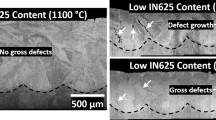Abstract
Infrared processing is a newly developed technique for materials processing. Key features include rapid processing, simplicity, and low cost. Because of the rapid processing, very little oxide forms on the surface of parts. Thus, a vacuum is not normally required. Using infrared infiltration, aluminum- and titanium-matrix composites have been prepared under an ambient argon atmosphere. Using infrared bonding, carbon/carbon composites, titanium-matrix composites, titanium alloys, intermetallic compounds, nickel-based superalloys, and steels have been joined without vacuum requirements. Infrared bonding for parts up to 1.27 cm thick is typically completed in 30 seconds to two minutes. Because of rapid processing, there are few microstructural or property changes in the base materials after joining.
Similar content being viewed by others
References
S.G. Warrier and R.Y. Lin, “Control of Interfaces in Titanium Matrix Composites Using Rapid Infrared Forming,” JOM, 45(3) (1993), pp. 24–27.
S.G. Warrier and R.Y. Lin, “Infrared Infiltration and Properties of SCS-6/Ti Al loy Composites,” submitted to /. Mat. Sci. (Dec. 1993).
S.G. Warrier and R.Y. Lin, “Interfacial Reaction in Titanium/SCS Fiber Composites During Fabrication,” Scr. Met. Mat., 28 (1993), pp. 313–318.
S.G. Warrier and R.Y. Lin, “Rapid Infrared Forming of Titanium/SCS Fiber Composites,” EPD Congress '93, ed. J.P. Hager (Warrendal e, PA: TMS, 1993), pp. 643–653.
S.G. Warrier and R.Y. Lin, “TiC Growth in C Fiber/Ti Al loy Composites During Liquid Infiltration,” Scr. Met. Mat., 29(2) (1993), pp. 147–152.
S.G. Warrier and R.Y. Lin, “Physical Chemistry of Interfacial Reactions During the Fabrication of Titanium Matrix Composite,” ICCM-IX, vol. 1 (1993), pp. 720–727.
S.G. Warrier, C.A. Blue, and R.Y. Lin, “Infiltration of Titanium Al loy-Matrix Composites,” J. Mat. Sci. Lett., 12 (1993), pp. 865–868.
S.G. Warrier and R.Y. Lin, “Fabrication of Al uminum and Titanium Matrix Composites by Infrared Pressureless Infiltration,” Proc. Am. Soc. Comp. Eights Tech. Conf. (Lancaster, PA: Technomic Publ. Co., 1993), pp. 561–569.
R.Y. Lin and S.G. Warrier, “Interfacial Reactions in Metal Matrix Composite Fabrication Using Infrared Processing,” Control of Interfaces in Metal and Ceramics Composites, ed. R.Y. Lin and S.G. Fishman (Warrendal e, PA: TMS, 1993), pp. 33–50.
S.G. Warrier and R.Y. Lin, “Carbide Formation in Infrared Processed Nical on Fiber/Al uminum Composites,” in Ref. 9, pp. 95–106.
S.G. Warrier, CA. Eppich, and R.Y. Lin, “Fabrication and Properties of SCS-2/A1 Composites,” submitted to Scr. Met. Mat. (Dec. 1993).
S.K. Wu et al, “Electron Microscopic Studies of Infrared Processed Al uminum Matrix Composites,” in Ref. 9, pp. 275–284.
S.G. Warrier and R.Y. Lin, “Infrared Processed Al uminum Matrix Composites and Carbide Formation at the Interface,” Scr. Met. Mat., 29(11) (1993), pp. 1513–1518.
S.G. Warrier and R.Y. Lin, “Interactions Between SiC Fibers and a Titanium Al loy During Liquid Infiltration,” submitted to Met. Trans. (January 1994).
S.G. Warrier and R.Y. Lin, “Effect of Heat Treatment on the Flexural Properties of a Titanium Matrix Composite,” Scr. Met. Mat., 27(8) (1992), pp. 1015–1020.
C.A. Blue and R.Y. Lin, “Rapid Infrared Joining of Titanium Al loys and Titanium Matrix Composites,” MRS Symp. Proc., vol. 314 (1993), pp. 143–148.
C.A. Blue, R.A. Blue, and R.Y. Lin, “Infrared Joining of Titanium Matrix Composites,” Proc. Am. Soc. Comp. Eights Tech. Conf. (Lancaster, PA: Technomic Publ. Co., 1993), pp. 903–908.
C.A. Blue et al., “ Joining of SCS-6/Beta 21S Titanium Composites,” accepted for publication, Processing Adv. Mat.
C.A. Blue and R.Y. Lin, “Rapid Infrared Joining of Ti-6A1-4V,” accepted for publication, Processing Adv. Mat.
C.A. Blue, R.A. Blue, and R.Y. Lin, “Infrared Joining of Titanium Al uminide,” submitted to Processing Adv. Mat. (November 1993).
Y. Ma et al., “Infrared Joining of Iron Al uminide,” submitted to Processing Adv. Mat. (October 1993).
C.A. Blue, C.C. Chen, and R.Y. Lin, “Infrared Bonding of Silicon Sensor Material to Ti-6A1-4V Al loy,” Proc. 5th Ann. Space Sys. Heal. Man. Tech. Conf. (Cincinnati, OH: NASA SERC, 1993), pp. 38–46.
C.A. Blue et al., “Rapid Infrared Joining Takes on the Advanced materials,” Welding J., 72(6) (1993), pp. 51–54.
C.A. Blue et al., “Infrared Joining of Titanium Matrix Composites,” NASP Quick Release CR-1153, NASA (April 1993).
C.A. Blue et al., “Rapid Sensor Bonding and the Bonding Strength—Physical Attachment of Sensors on Rocket Engine,” Proc. Third Ann. Heal. Monit. Conf. (Cincinnati, OH: NASA SERC, 1991), pp. 401–423.
H.E. Boyer and T.L. Gal l, ed., Metal s Handbook, sec. 28 (Metal s Park, OH: ASM, 1985), p. 78.
T. Schoenberg, Engineering materials Handbook—Composites, vol. 1, ed. T.J. Reinhart (Metal s Park, OH: ASM, 1987), p. 58.
S. Sarian, “Diffusion of Carbon in TiC,” J. Appl. Phys., 39(7) (1968), pp. 3305–3310.
S. Sarian, “Diffusion of Ti in TiC,” J. Appl. Phys., 40(9) (1969), pp. 3515–3520.
S. Sarian, “Anomal ous Diffusion of C in TiC,“ J. Appl. Phys., 39(11) (1968), pp. 5036–5041.
S. Sarian, “A Summary of Self-Diffusion and Impurity Diffusion in Cubic (NaCl-Type) Carbides,” Recent Advances in Science and Technology of materials, vol. 3, ed. A. Bishay (New York, NY: Plenum Press, 1974), pp. 427–270.
P.G. Shewmon, Diffusion in Solids, 2nd ed. (Warrendal e, PA: TMS, 1989).
C. Jones, C.J. Kiely, and S.S. Wang, J. Mater. Res., 5(7) (1990), pp. 1435–1442.
X.J. Ning and P. Pirouz, J. Mater. Res., 9(10) (1991) pp. 2234–2248.
Textron Special ty materials, “Continuous Silicon Carbide Metal Matrix Composites,” Lowell, MA (1991).
L.M. Adelsberg and L.H. Cadoff, Trans. AIME, 239 (1967), pp. 933–935.
Author information
Authors and Affiliations
Rights and permissions
About this article
Cite this article
Lin, R.Y., Warner, S.G., Blue, C.A. et al. The infrared infiltration and joining of advanced material. JOM 46, 26–30 (1994). https://doi.org/10.1007/BF03220645
Issue Date:
DOI: https://doi.org/10.1007/BF03220645



